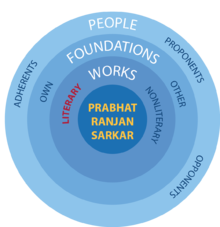Dasha, Bhava and Mahabhava: Difference between revisions
m (Removed incorrect info) |
m (Added quote) |
||
| Line 18: | Line 18: | ||
== Synopsis == | == Synopsis == | ||
{{Quote box|width=360px|bgcolor=|align=left|quoted=1|salign=right|quote= |source=Shrii Shrii Anandamurti}} | {{Quote box|width=360px|bgcolor=|align=left|quoted=1|salign=right|quote=This mahábháva is clearly distinguished from dashá and bháva. When the sádhaka clearly feels the thrill of divine existence around him at the time of sádhaná, the state of bliss as experienced by the sádhaka is described as dashá. When the sádhaka feels the existence of the divine world around him, as also the source from which the divine existence comes, the state of bliss the sádhaka experiences at the time of sádhaná is bháva. Again, when the sádhaka feels the closest proximity of Parama Puruśa, even within his embrace, that bháva is called mahábháva.|source=Shrii Shrii Anandamurti}} | ||
In this discourse, Anandamurti explains <ref name="AV33"/> | In this discourse, Anandamurti explains <ref name="AV33"/> | ||
Revision as of 01:40, 19 July 2019
| This article or section is in the process of an expansion or major restructuring. You are welcome to assist in its construction by editing it as well. If this article or section has not been edited in several days, please remove this template. This article was last edited by Abhidevananda (talk | contribs) 4 years ago. (Purge) |
| Dasha, Bháva and Mahábháva | |
|---|---|
| Speaker | Shrii Shrii Anandamurti |
| Date | 1969 |
| Time | Unknown |
| Place | Ranchi, India |
| Topic | Various trance states |
| Included in | Ananda Vacanamrtam Part 33 |
| Location in Sarkarverse | |
Dasha, Bháva and Mahábháva is a discourse given by Shrii Shrii Anandamurti in 1969 in Ranchi, India. This discourse is the twelfth chapter of Ananda Vacanamrtam Part 33.[1]
Synopsis
This mahábháva is clearly distinguished from dashá and bháva. When the sádhaka clearly feels the thrill of divine existence around him at the time of sádhaná, the state of bliss as experienced by the sádhaka is described as dashá. When the sádhaka feels the existence of the divine world around him, as also the source from which the divine existence comes, the state of bliss the sádhaka experiences at the time of sádhaná is bháva. Again, when the sádhaka feels the closest proximity of Parama Puruśa, even within his embrace, that bháva is called mahábháva.
In this discourse, Anandamurti explains [1]
References
| Preceded by Abhedajiṋána and Daeshika Vyavadhána Vilopa |
Ananda Vacanamrtam Part 33 With: Dasha, Bháva and Mahábháva |
Succeeded by Samádhi and Mrtyu |
